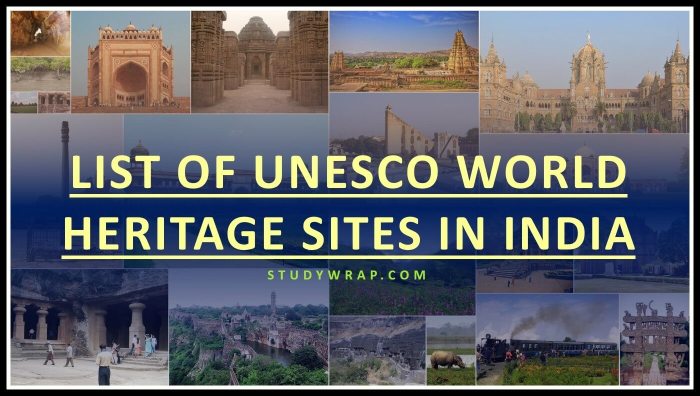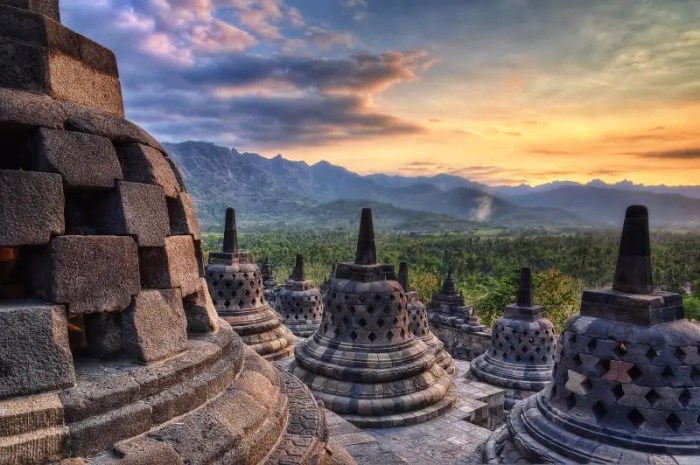
UNESCO World Heritage site tours set the stage for this enthralling narrative, offering readers a glimpse into a story that is rich in detail and brimming with originality from the outset. From spiritual journeys to remote destinations, luxury train journeys to cycling tours, these tours promise a unique blend of history, culture, and natural beauty that captivate travelers worldwide.
Introduction to UNESCO World Heritage Site Tours
UNESCO World Heritage sites are landmarks or areas that have been recognized by the United Nations Educational, Scientific and Cultural Organization (UNESCO) for their cultural, historical, scientific, or other forms of significance. These sites are considered to be of outstanding value to humanity and are protected for future generations.
Significance of UNESCO Designation
Being designated as a UNESCO World Heritage site is a prestigious honor that highlights the unique qualities and importance of a cultural or natural site. It helps in preserving and promoting these sites, ensuring their conservation and sustainable management for years to come. UNESCO designation also attracts international attention, funding, and support for the protection and maintenance of these sites.
Popularity of UNESCO World Heritage Site Tours
UNESCO World Heritage site tours have gained immense popularity among travelers and tourists seeking to explore and learn about these exceptional places. These tours offer a chance to immerse oneself in the rich history, architecture, and natural beauty of these sites, providing a unique and unforgettable travel experience. Visitors are drawn to these sites to witness firsthand the remarkable heritage and cultural diversity they represent.
Spiritual Journeys on UNESCO World Heritage Site Tours
In addition to their cultural and historical significance, UNESCO World Heritage sites often hold deep spiritual connections that attract visitors seeking profound experiences. Exploring these sites can offer a unique opportunity to connect with the spiritual essence of a place and delve into its sacred history.
Examples of UNESCO Sites Known for Their Spiritual Significance
- The ancient city of Petra in Jordan, known for its rock-cut architecture and significance in various religious traditions.
- The Camino de Santiago in Spain, a pilgrimage route leading to the shrine of the apostle St. James in Santiago de Compostela, attracting spiritual seekers from around the world.
- Angkor Wat in Cambodia, a majestic temple complex dedicated to the Hindu god Vishnu, showcasing intricate carvings and spiritual symbolism.
- Machu Picchu in Peru, an ancient Incan citadel nestled in the Andes mountains, believed to have served as a spiritual retreat for Incan rulers.
Combining Spirituality with Cultural Heritage on Tours
Exploring UNESCO World Heritage sites through a spiritual lens allows visitors to not only appreciate the architectural wonders and historical significance but also to connect on a deeper level with the beliefs and practices of the past. By immersing oneself in the spiritual aspects of these sites, travelers can gain a profound understanding of the cultural heritage intertwined with religious traditions, creating a holistic and enriching tour experience.
Remote Destinations for UNESCO World Heritage Site Tours
Exploring remote UNESCO World Heritage sites offers a unique opportunity to discover hidden gems off the beaten path. These lesser-known locations provide travelers with unforgettable experiences that are rich in history, culture, and natural beauty.
Lesser-Known UNESCO Sites in Remote Locations
While many UNESCO World Heritage sites are popular tourist destinations, there are several remote locations that are lesser-known but equally captivating. Some examples include:
- The Rock Islands Southern Lagoon in Palau, known for its stunning marine biodiversity and unique geological formations.
- The Ruins of Kilwa Kisiwani and Songo Mnara in Tanzania, showcasing the remnants of Swahili coastal trading towns.
- The Historic Centre of Saint-Louis in Senegal, a colonial town with a blend of African and European architecture.
Unique Experiences at Remote UNESCO Sites
Visiting remote UNESCO World Heritage sites allows travelers to immerse themselves in untouched landscapes, interact with local communities, and gain a deeper understanding of diverse cultures. Some unique experiences include:
- Participating in traditional ceremonies and rituals with indigenous tribes.
- Exploring ancient ruins and archaeological sites that are off the typical tourist radar.
- Engaging in eco-friendly activities such as bird-watching, hiking, and wildlife conservation efforts.
Challenges and Rewards of Visiting Remote UNESCO Sites
While traveling to remote UNESCO World Heritage sites can present challenges such as limited infrastructure, rough terrain, and language barriers, the rewards are often worth the effort. Some of the challenges and rewards include:
- Challenges: Navigating remote locations with limited transportation options and accommodations can be daunting for some travelers.
- Rewards: Experiencing authentic cultural exchanges, breathtaking landscapes, and a sense of adventure that comes with exploring off-the-beaten-path destinations.
- Challenges: Adapting to different climates, food, and customs in remote areas may require flexibility and open-mindedness.
- Rewards: Discovering hidden treasures, connecting with nature, and gaining a new perspective on the world through unique travel experiences.
Theme Park Vacations and UNESCO World Heritage Site Tours
When it comes to planning vacations, two popular options that often come to mind are theme park visits and UNESCO World Heritage site tours. While both offer unique experiences, they cater to different interests and preferences.
Contrast between Theme Park Vacations and UNESCO Site Tours
Theme park vacations are known for their thrilling rides, entertaining shows, and vibrant atmosphere designed for fun and excitement. On the other hand, UNESCO World Heritage site tours focus on preserving cultural and natural treasures, providing opportunities for historical exploration and educational experiences.
UNESCO Sites Near Popular Theme Parks
- Chichen Itza in Mexico is close to several theme parks in Cancun, offering visitors the chance to explore ancient Mayan ruins while also enjoying modern attractions.
- Plitvice Lakes National Park in Croatia is located near the coastal city of Split, known for its stunning waterfalls and UNESCO-protected natural beauty.
Benefits of Incorporating Cultural Heritage into Theme Park Vacations
By incorporating UNESCO World Heritage site tours into theme park vacations, travelers can enjoy a well-rounded experience that combines entertainment with cultural enrichment. This fusion allows visitors to appreciate the diversity of human history and natural wonders while having a memorable and educational trip.
Private Jet Travel for UNESCO World Heritage Site Tours
Private jet travel for UNESCO World Heritage Site tours offers a luxurious and exclusive experience for travelers looking to explore these renowned sites in style and comfort.
Luxury Travel Experience
Traveling to UNESCO World Heritage Sites via private jet ensures a high level of comfort and convenience throughout the journey. From personalized services to spacious cabins, travelers can enjoy a VIP experience from the moment they step on board.
- Exclusive Access: Private jets allow travelers to access remote UNESCO sites that may be difficult to reach by commercial airlines or other modes of transportation.
- Customized Itineraries: Private jet tours offer the flexibility to create personalized itineraries, allowing travelers to visit multiple UNESCO sites in a single trip.
- Luxurious Amenities: Private jets are equipped with luxurious amenities, including gourmet catering, comfortable seating, and in-flight entertainment, enhancing the overall travel experience.
Convenience and Exclusivity
Private jet travel for UNESCO tours offers unparalleled convenience and exclusivity, catering to travelers seeking a premium travel experience.
- Efficient Travel: Private jets operate on flexible schedules, allowing travelers to optimize their time and visit multiple UNESCO sites in a short period.
- Personalized Service: Private jet tours come with personalized service, including dedicated staff to cater to the needs and preferences of each traveler.
- Privacy and Exclusivity: Traveling on a private jet ensures privacy and exclusivity, providing a comfortable and stress-free environment for exploring UNESCO sites.
Environmental Impact
While private jet travel offers luxury and convenience, it also raises concerns about the environmental impact on UNESCO site visits.
- Carbon Footprint: Private jets emit a significant amount of carbon dioxide compared to commercial flights, contributing to environmental pollution and climate change.
- Sustainability Efforts: Some private jet operators are implementing sustainability initiatives to reduce the environmental impact of private jet travel, such as carbon offset programs and eco-friendly aircraft technologies.
- Balancing Luxury and Sustainability: Travelers can support sustainable travel practices by choosing eco-friendly private jet operators and offsetting their carbon footprint to minimize the impact on UNESCO World Heritage Sites.
Luxury Train Journeys to UNESCO World Heritage Sites
Embark on a lavish adventure through time and culture with luxury train journeys to UNESCO World Heritage Sites. These exclusive routes offer a unique way to explore the world’s most treasured destinations.
Luxury Train Routes to UNESCO Sites
Experience opulence and history intertwine as you travel in style to UNESCO World Heritage Sites. Some of the most notable luxury train routes include:
- The Orient Express: Journey through Europe in unparalleled luxury, visiting sites like the Palace of Westminster in the United Kingdom.
- The Blue Train: Explore South Africa’s diverse landscapes and cultural sites, including the Cradle of Humankind.
- The Maharajas’ Express: Delve into India’s rich heritage with stops at iconic sites like the Taj Mahal.
Allure of Train Travel for Cultural and Natural Wonders
Train travel offers a unique perspective on UNESCO World Heritage Sites, allowing passengers to witness breathtaking landscapes and immerse themselves in local cultures. The slow pace of train journeys adds a sense of anticipation and wonder, enhancing the overall experience.
Historical Significance of Train Journeys in Relation to UNESCO Sites
Trains have played a pivotal role in connecting civilizations and shaping the modern world. Many UNESCO World Heritage Sites, such as the Darjeeling Himalayan Railway in India, have historical ties to the development of railway networks. By embarking on luxury train journeys, travelers can appreciate the historical significance of these sites in a luxurious setting.
Agricultural Tourism at UNESCO World Heritage Sites
Agricultural practices have been an integral part of many UNESCO World Heritage Sites, contributing to their unique designations. These sites showcase the importance of sustainable agriculture and its role in preserving cultural landscapes and traditions for future generations.
Examples of UNESCO Sites with Agricultural Importance
- The Rice Terraces of the Philippine Cordilleras: These ancient terraces carved into the mountainside by indigenous communities are not only a breathtaking sight but also a testament to sustainable farming practices that have been passed down for generations.
- Val d’Orcia, Italy: This stunning valley in Tuscany is known for its picturesque vineyards, olive groves, and wheat fields, showcasing the harmony between agriculture and landscape preservation.
- Gros Morne National Park, Canada: This site combines stunning natural beauty with traditional farming practices of the local communities, highlighting the importance of agriculture in shaping the cultural identity of the region.
Benefits of Promoting Sustainable Agriculture through Tourism
- Preservation of Cultural Heritage: By promoting sustainable agriculture at UNESCO sites, we can help preserve traditional farming methods, cultural landscapes, and indigenous knowledge that are integral to the site’s significance.
- Economic Development: Agricultural tourism can provide local communities with opportunities for income generation through activities such as farm tours, tastings, and workshops, contributing to sustainable development.
- Environmental Conservation: Sustainable agriculture practices not only help maintain the ecological balance of the site but also promote biodiversity and soil health, ensuring the long-term sustainability of the landscape.
Cycling Tours Exploring UNESCO World Heritage Sites
Exploring UNESCO World Heritage Sites on cycling tours offers a unique and immersive experience that allows visitors to connect with the cultural and natural wonders in a more intimate way.
Advantages of Exploring UNESCO Sites on Cycling Tours
- Opportunity to explore off-the-beaten-path sites that are inaccessible by vehicles.
- Closer interaction with local communities and the environment.
- Promotes sustainable and eco-friendly travel practices.
- Enhanced health benefits through physical activity and outdoor exploration.
UNESCO Sites Well-Suited for Cycling Tours
- Machu Picchu, Peru: The ancient Incan ruins offer scenic cycling routes with breathtaking views of the Andes Mountains.
- Loire Valley, France: Explore the picturesque vineyards, castles, and charming villages on a leisurely cycling tour.
- Angkor Wat, Cambodia: Cycle through the sprawling temple complex and surrounding jungle for a unique perspective of this UNESCO site.
Cultural and Environmental Benefits of Cycling at UNESCO Sites
- Reduced carbon footprint compared to traditional transportation methods.
- Promotes cultural exchange and understanding by interacting with local communities along the cycling route.
- Preserves the natural environment by minimizing the impact of tourism on fragile ecosystems.
- Encourages respect for heritage sites and helps raise awareness about their preservation.
Wine and Vineyard Tours at UNESCO World Heritage Sites
Embark on a journey to explore the rich connection between wine production and UNESCO World Heritage sites. Delve into the cultural significance of vineyards and wine within these prestigious designations.
UNESCO Sites Known for Vineyards and Wine Heritage
- Valle de la Orotava, Spain: This UNESCO site is famous for its historic vineyards that produce exquisite wines, showcasing the region’s winemaking traditions.
- Burgundy, France: A region renowned for its prestigious vineyards and winemaking expertise, designated as a UNESCO World Heritage site for its cultural landscape.
- Douro Valley, Portugal: Home to terraced vineyards producing world-class Port wine, this site exemplifies the harmony between nature and winemaking traditions.
Cultural Significance of Wine and Vineyards in UNESCO Designations
- Historical Legacy: Many UNESCO sites with vineyards have a long history of winemaking, reflecting ancient traditions and practices passed down through generations.
- Cultural Identity: Wine and vineyards are often intertwined with the cultural identity of a region, shaping its cuisine, festivals, and social gatherings.
- Economic Importance: The wine industry plays a vital role in the economy of UNESCO sites, supporting local businesses and contributing to sustainable development.
Heritage Tourism and UNESCO World Heritage Site Tours

Heritage tourism refers to the practice of traveling to places that hold cultural, historical, or natural significance. UNESCO World Heritage sites are designated locations recognized for their outstanding universal value, contributing to the collective heritage of humanity. The connection between heritage tourism and UNESCO World Heritage sites lies in the promotion and preservation of these iconic landmarks for future generations to appreciate and learn from.
Impact of Heritage Tourism on the Preservation of UNESCO Sites
Heritage tourism plays a crucial role in the conservation and protection of UNESCO World Heritage sites. The influx of visitors not only generates revenue for maintenance and restoration efforts but also raises awareness about the importance of safeguarding these sites. Through responsible tourism practices and sustainable development initiatives, heritage tourism can contribute to the long-term preservation of these invaluable cultural and natural treasures.
- Increased funding for conservation projects
- Heightened public awareness and appreciation for heritage sites
- Promotion of sustainable tourism practices to minimize environmental impact
- Engagement of local communities in site management and preservation efforts
Role of Storytelling in Enhancing Visitor Experience at UNESCO Sites
Storytelling serves as a powerful tool in enriching the visitor experience at UNESCO World Heritage sites, bringing history and culture to life through narratives and interpretations. By weaving compelling stories that highlight the significance and relevance of these sites, visitors can develop a deeper connection and appreciation for the heritage they encounter.
“Stories have the power to evoke emotions, create memorable experiences, and foster a sense of belonging to the cultural tapestry of a place.”
- Interpretive tours led by knowledgeable guides
- Interactive exhibits and multimedia presentations
- Local folklore and legends shared with visitors
- Incorporation of oral traditions and personal accounts into site narratives
City Breaks with UNESCO World Heritage Site Tours

City breaks offer a quick getaway to explore the vibrant culture and history of popular urban destinations. When combined with UNESCO World Heritage site tours, these trips become even more enriching, providing a deeper insight into the heritage of these cities.
Attractions of City Breaks with UNESCO Site Tours
- City breaks allow travelers to experience the bustling streets, local cuisine, and modern amenities of urban centers.
- UNESCO World Heritage site tours offer the opportunity to delve into the historical significance and architectural wonders of these designated sites.
- Combining city breaks with UNESCO tours creates a perfect blend of contemporary city life and ancient cultural heritage.
UNESCO Sites in Popular City Destinations
- Rome, Italy: The historic center of Rome, including iconic sites like the Colosseum and Vatican City, is a UNESCO World Heritage site.
- Paris, France: The banks of the Seine River in Paris, along with landmarks such as Notre Dame Cathedral, are designated UNESCO sites.
- Istanbul, Turkey: The Historic Areas of Istanbul, with treasures like the Hagia Sophia and Topkapi Palace, are UNESCO-listed sites.
Cultural Enrichment from UNESCO Site Tours
- Exploring UNESCO World Heritage sites during city breaks offers a deeper understanding of the historical and cultural significance of these locations.
- Visitors can appreciate the art, architecture, and traditions preserved at UNESCO sites, enhancing their overall travel experience.
- Engaging with local guides and experts at UNESCO sites provides insights into the unique heritage and stories behind these designated locations.
Last Recap
As UNESCO World Heritage site tours continue to allure travelers with their rich tapestry of experiences, they stand as a testament to the enduring legacy of humanity’s past and natural wonders. Whether you seek spiritual enlightenment, remote adventures, or luxury travel, these tours offer a gateway to a world of cultural treasures waiting to be explored and cherished for generations to come.
General Inquiries
How are UNESCO World Heritage sites chosen?
UNESCO designates sites based on their cultural, historical, scientific, or other forms of significance, ensuring their protection and preservation for future generations.
Are there any UNESCO World Heritage sites near theme parks?
Yes, some UNESCO sites are located near popular theme parks, offering a unique blend of cultural heritage and modern entertainment.
What is the significance of promoting sustainable agriculture at UNESCO sites?
Promoting sustainable agriculture not only helps preserve the heritage of these sites but also contributes to environmental conservation and local community development.
Why are cycling tours a great way to explore UNESCO World Heritage sites?
Cycling allows travelers to immerse themselves in the cultural and natural beauty of UNESCO sites while promoting eco-friendly and sustainable travel practices.
What role does storytelling play in enhancing the visitor experience at UNESCO sites?
Storytelling helps bring the history and significance of UNESCO sites to life, creating a more engaging and immersive experience for visitors.





